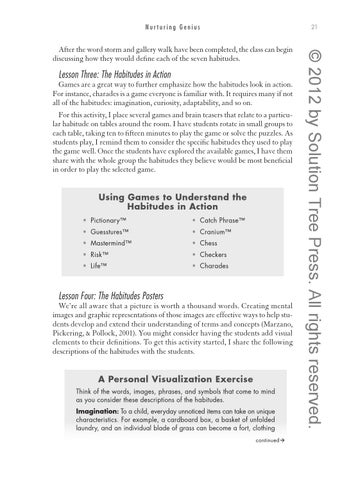N u r t u r i n g G e n i u s : A F r a m e w No rukr t fuor ri nTge aGcehni inugs a n d L e a r n i n g t h e H a b i t u d e s
Lesson Three: The Habitudes in Action
Games are a great way to further emphasize how the habitudes look in action. For instance, charades is a game everyone is familiar with. It requires many if not all of the habitudes: imagination, curiosity, adaptability, and so on. For this activity, I place several games and brain teasers that relate to a particular habitude on tables around the room. I have students rotate in small groups to each table, taking ten to fifteen minutes to play the game or solve the puzzles. As students play, I remind them to consider the specific habitudes they used to play the game well. Once the students have explored the available games, I have them share with the whole group the habitudes they believe would be most beneficial in order to play the selected game.
Using Games to Understand the Habitudes in Action • Pictionary™
• Catch Phrase™
• Guesstures™
• Cranium™
• Mastermind™
• Chess
• Risk™
• Checkers
• Life™
• Charades
Lesson Four: The Habitudes Posters
We’re all aware that a picture is worth a thousand words. Creating mental images and graphic representations of those images are effective ways to help students develop and extend their understanding of terms and concepts (Marzano, Pickering, & Pollock, 2001). You might consider having the students add visual elements to their definitions. To get this activity started, I share the following descriptions of the habitudes with the students.
A Personal Visualization Exercise Think of the words, images, phrases, and symbols that come to mind as you consider these descriptions of the habitudes. Imagination: To a child, everyday unnoticed items can take on unique characteristics. For example, a cardboard box, a basket of unfolded laundry, and an individual blade of grass can become a fort, clothing continuedà
© 2012 by Solution Tree Press. All rights reserved.
After the word storm and gallery walk have been completed, the class can begin discussing how they would define each of the seven habitudes.
21
